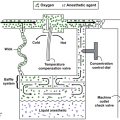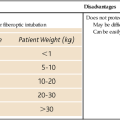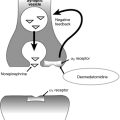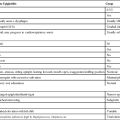Malignant hyperthermia
Clinical presentation
Clinical signs and symptoms reflect a state of highly increased metabolism. The onset of hyperthermia is often delayed (Table 245-1). The earliest signs of MH include increased end-tidal CO2 levels, tachycardia, and tachypnea (in an unparalyzed patient). The results of laboratory tests can be used to support a diagnosis of MH (Table 245-2).
Table 245-1
Clinical Signs of Malignant Hyperthermia
| ↑ Temperature | ↑ Sympathetic Activity |
| Tachypnea | Tachycardia |
| Rhabdomyolysis | Arrhythmia |
| Metabolic/respiratory acidosis | Sweating |
| Rigidity* | Hypertension |
Table 245-2
Laboratory Test Findings That Support a Diagnosis of Malignant Hyperthermia (MH)
| Laboratory Test | Results in Patients with MH |
| End-tidal CO2 concentration | ↑ |
| Blood gas analysis* | Metabolic acidosis |
| Serum CK† | ↑ |
| Serum and urine myoglobin | Positive |
| Serum K+, Ca2+, and lactate | ↑ |
*Mixed venous, arterial, or venous sample.
†Creatine kinase (CK) levels should be measured every 6 hours for 24 hours.
Evaluation of the patient with malignant hyperthermia susceptibility
Patients are referred for evaluation of MH susceptibility for a number of reasons (Box 245-1). A serum creatine phosphokinase level is often obtained in patients who are thought to be MHS. This value is elevated in approximately 70% of affected individuals; therefore, the results may be inconclusive.
Source for further assistance
MHAUS is a lay organization with a medical MH expert advisory group that provides support for patients and anesthesia providers. It publishes books, pamphlets, and a quarterly newsletter at nominal costs; sponsors a website (mhaus.org); and manages a 24-h hotline (1-800-MHHYPER) to provide assistance to anesthesia providers managing MHS patients or treating patients with acute MH episodes.






